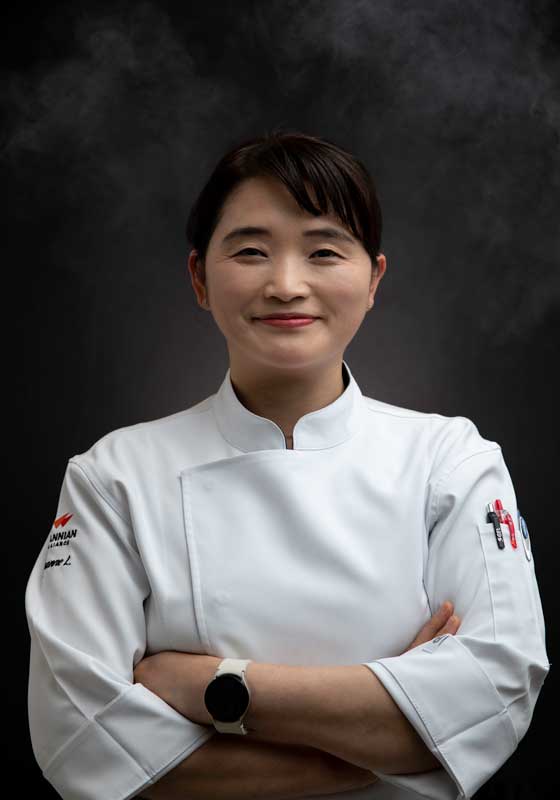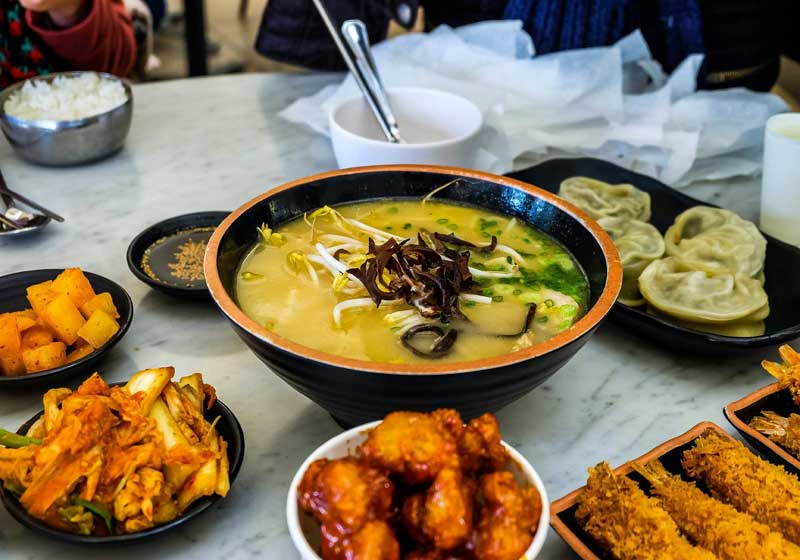By Marie-Antoinette Issa.
Korea is known for its multi-step skincare routines and K-pop stars, however, its delicious dishes are equally deserving of their time in the spotlight. In this guide, Joanne Lee, Executive Group Chef of Arisun and Butchers Buffet shares her insider tips and tricks on cooking with Korean ingredients.

Kings of the Korean kitchen
To capture the essence of Korean cuisine, Joanne emphasises the importance of a few key ingredients:
"In Korean cooking, soy sauce is a fundamental seasoning," she explains. "It’s used in everything from marinades to soups and stir-fries, adding depth and umami to the dishes."
Joanne highlights the different types of soy sauce used in Korean kitchens:
"Regular soy sauce is used for everyday cooking, while soup soy sauce is ideal for broths and clear soups. Sweet soy sauce adds a touch of sweetness to braised dishes and dark soy sauce is used sparingly to enrich colour and flavour.”
Another crucial component is gochugaru or Korean chilli powder. Gochugaru brings the signature heat and rich, complex flavours to Korean dishes and is often used in kimchi and stews.
Joanne also stresses the importance of fermented soybean paste, or doenjang. "Doenjang is Korea’s answer to miso. It’s used in soups, stews and sauces, offering a robust, earthy flavour," she explains. Garlic, another staple, is also generously used in Korean cooking for its pungent and aromatic qualities.
Finally, Joanne highlights the role of gochujang (red pepper paste) in Korean cooking. "Gochujang adds a sweet, spicy and savoury kick to sauces and marinades. It’s essential in dishes like bibimbap and various stews, where it provides a balanced, rich flavour. The complex taste of gochujang is integral to achieving the depth and authenticity of Korean dishes.”

Fabulous fermentation
Fermented ingredients, particularly kimchi, are also central to Korean cuisine.
Kimchi isn’t just a side dish - it’s a cultural icon and a staple in nearly every Korean meal; the fermentation process not only preserves vegetables but also creates a complex flavour profile with tangy, spicy and umami notes, which are characteristic of Korean food. Fermented ingredients like kimchi, doenjang and gochujang also offer health benefits, such as probiotics that support gut health.
For those looking to make homemade kimchi, Joanne offers several tips:
"Start with fresh, firm wombok (napa cabbage) and high-quality Korean gochugaru," she advises. "Salting the cabbage properly is also crucial; as it helps with fermentation and maintains the cabbage’s crunch. Massage the salt into each leaf and let it sit until the leaves become pliable.”
The kimchi paste, typically made from gochugaru, garlic, ginger, fish sauce and sometimes sugar or rice flour, gives kimchi its distinctive taste. Adjust the spice level to your preference.
Joanne suggests adding extra vegetables like daikon, carrots or spring onions for variety and texture.
"After packing the kimchi into jars, let it ferment at room temperature for a day or two before transferring it to the fridge," she says. The flavour will develop over time, so taste periodically to achieve your desired level of tanginess. Proper storage in airtight containers helps control fermentation and prevents strong odours from affecting other foods in the fridge.

The rice is nice
Korean rice varieties each have their specific uses - for example, short-grain white rice is ideal for everyday meals such as bibimbap or as a side to various Korean dishes. "It is often mixed with brown rice for a healthier option and to add more texture and a nutty flavour," Joanne adds.
Black rice is used to create visually striking dishes and can be mixed with other rice for added nutrition and colour, while sweet rice, with its sticky consistency, is perfect for desserts and rice cakes.
Beyond the grain, Joanne encourages exploring lesser-known Korean ingredients.
"Perilla leaves are fantastic for adding a burst of flavour when used as a fresh wrap for meats, in salads, or as a garnish," she suggests. Korean pancake mix is another ingredient Joanne finds useful. "It’s great for making quick savoury pancakes with your favourite veggies or proteins."
For soups and salads, chrysanthemum greens, with their slightly bitter, herbal note, can enhance the overall taste profile; while Korean plum extract, used in dressings, marinades, or as a sweetener in beverages, adds a unique flavour.
Fermented shrimp is another ingredient that can enhance umami in stews, soups, or even as a secret ingredient in your kimchi, Joanne reveals.

Tastes and techniques
Joanne explains that Korean Chefs aim for harmony in their dishes. "In Korean cooking, no single flavour should dominate. For instance, in kimchi jjigae (kimchi stew), the spiciness of the kimchi is balanced by the umami of doenjang, the saltiness of soy sauce and a hint of sweetness from added sugar or fruit," she says.
This interplay between sweet, salty, sour and spicy elements creates a complex, layered taste that keeps the palate engaged.
Joanne outlines several common Korean cooking techniques:
"Grilling (gui) is popular for meats like bulgogi and samgyeopsal, often done over charcoal for a smoky flavour. Stir-frying (bokkeum) is used for quick dishes like japchae," she explains. "Fermenting is central to Korean cuisine, with kimchi being the most famous example.
"Stewing (jjigae) involves simmering ingredients together to create rich, flavourful stews, while blanching (sukchae) briefly boils vegetables to retain crispness. Braised dishes (jorim) are slow-cooked in a seasoned broth and pickling adds tanginess to meals.”

Finally, for those keen to replicate their favourite Korean cuisines at home, presentation is paramount.
"Dishes like bibimbap are arranged artfully to showcase vibrant colours. The vegetables and sauces are meant to make the dish visually appealing," Joanne says.
Small side dishes, or banchan, are served in multiple bowls, each carefully prepared to offer a variety of flavours and textures. Grilled meats are often served with fresh lettuce and perilla leaves for wrapping, adding an interactive element to the meal.








